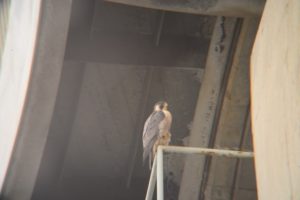Development and Breeding Birds
Here’s What You Need To Know
By: Katharine Scotton, R.P.Bio.
kscotton@pggroup.com
If your project requires the removal of, or disturbance near, vegetation, it is important to understand your obligations under provincial and federal legislation regarding breeding birds. Without informed guidance and planning, your project may experience costly delays if breeding birds and nests are encountered.
Active bird nests are protected under the BC Wildlife Act. Active nests may not be removed, injured, molested, or destroyed. Nests of some species, including bald eagle, peregrine falcon, gyrfalcon, burrowing owl, osprey, and heron, are protected year-round, whether currently active or not. Additionally, the nests and eggs of some species are also protected under the federal Migratory Birds Convention Act and the Species at Risk Act. Disturbance that causes a nest to fail is considered an offence under these Acts. Some species are exempt from the BC Wildilfe Act (nuisance and non-native species), and are found in Schedule C, here.
How to Avoid Breeding Birds
Least-risk windows have been developed as best management practices (BMPs) to guide developers and environmental professionals. It is highly recommended that clearing and disturbance activities occur within the least-risk windows wherever possible. Least-risk windows are based on breeding activity including courtship, nest-building, and active nesting, which could be disturbed by human presence and construction activity. General least-risk windows are as follows:
| Species | Least-Risk Window for BC |
| Bald eagle | September 1 – December 31 |
| Osprey | September 15 – March 31 |
| Heron | September 15 – January 15 |
| Other Raptors | October 1 – February 28 |
| Passerines (songbirds) | September 1 – February 28 |
Source: Ministry of Environment. 2014. Develop with Care 2014: Environmental Guidelines for Urban and Rural Land Development in British Columbia. Victoria, BC. Available at: https://www2.gov.bc.ca/gov/content/environment/natural-resource-stewardship/laws-policies-standards-guidance/best-management-practices/develop-with-care
If in doubt, contact PGL to walk you through the least-risk windows and how they apply to your project site.

Not Just Trees!
Least-risk windows and provincial and federal legislation don’t just apply to trees. Birds may also nest in grass, low vegetation, and shrubs, in addition to locations that are unvegetated, including gravel surfaces (such as parking lots or roof tops), abandoned buildings, and under eaves, and industrial infrastructure such as bridges (Photograph 1). Activities that disturb any bird nest, whether in vegetation or not, are prohibited.
When to Retain A Qualified Environmental Professional
If your project’s activities cannot occur during the least-risk windows, a Qualified Environmental Professional (QEP) should be retained to assess your project’s risk of disturbance to breeding birds, and to help you develop a path forward. Some municipalities will require a letter from a QEP confirming a pre-clearing nest survey has been completed prior to approving tree cutting permits.
BMPs recommend pre-clearing bird nest surveys when conducting work outside of the least-risk windows. A QEP will work with you to schedule pre-clearing nest surveys suitable to the conditions of your site. Surveys may take place over two to three days within a five-day window to ensure appropriate coverage of your site and to conform with provincial and federal survey guidelines. The QEP will create a no-disturbance buffer around active nests based on BMPs and behavioural observations of the active nest site. The QEP will reassess the nest at a later date to confirm the nest has fledged or is no longer active.
How Can PGL Help You?
PGL has QEPs experienced in bird ecology and pre-clearing bird nest surveys and has provided strategic advice and support to our clients to protect breeding birds while meeting the goals of the project. Advanced planning has allowed our clients to avoid delays by clearing outside of least-risk windows. We have also developed mitigation plans to prevent disturbance to nesting birds, in situations where clearing or activity in the breeding season could not be avoided.
